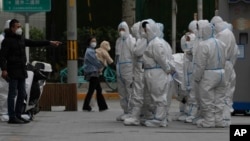Protests have erupted across China over the country's strict pandemic restrictions. The demonstrations indicate that many Chinese have grown weary of the lengthy lockdowns and widespread testing that is a part of China's "zero-COVID" policy. Here is a closer look at the policy.
What is China's COVID strategy?
China's goal in fighting COVID-19 is to keep cases as close to zero as possible. To achieve this, it has implemented mass testing, quarantined the sick in government facilities and imposed strict lockdowns that can span entire cities.
When did the policy begin?
China surprised the world when it locked down the entire city of Wuhan during the initial outbreak of the virus in 2019, confining more than 11 million residents to their homes. Since then, China has continued with the same methods, making them part of its zero-COVID policy.
What is Beijing's reasoning for the policy?
China says its strategy has kept coronavirus cases and deaths low compared with Western countries. China has nearly 16,000 COVID-19 deaths among its population of 1.4 billion, according to the Johns Hopkins Coronavirus Resource Center, while the United States — the country hardest-hit by the pandemic — has recorded more than a million deaths.
What is the public's response?
Initially, public discontent over the government's approach was minimal with many expressing pride in the country's ability to keep cases to almost none. However, as the virus has become more transmittable, cases have increased across China and lockdowns have become more severe. Public anger has mounted, leading to protests in multiple cities.
What are China's methods?
China's national zero-COVID policy is implemented at the local level. While policies can vary by region, they all tend to employ the following methods:
- Lockdowns can be established even if only a few COVID-19 cases are detected. The affected area can span neighborhoods or even entire cities. Major cities have been shut down for weeks or months at a time.
- Contract tracing apps are used by authorities to monitor people's movements to try to track the spread of the virus. Residents need to use the app to enter public places and are notified if they cross paths with an infected person or travel to a high-risk area, resulting in mandatory testing or isolation.
- The government carries out mass testing in places where COVID-19 has been reported. Even in places where there have been no new cases, residents often need to have a recent negative COVID-19 test to be able to enter a business or public facility.
- Anyone who has been in contact with an infected person is either put in government quarantine facilities or ordered to isolate. Even those who had only distant contact with an infected person or potentially infected person can be made to isolate. Such isolation can be enforced with electronic seals attached to residents' doors.
What are the policy's negative effects?
While's China's COVID-19 policy has kept case numbers lower than in most countries, the methods have come at a cost, including:
- Lockdowns in some cities, such as Yining in the northwest, have led to widespread shortages of food and other daily necessities.
- China's zero-COVID policy has had a huge effect on the economy, including global supply chains. Beijing's target economic growth for 2022 was 5.5%, but the country's economy had grown only 3.9% in the past year ending in September.
- The policy has also greatly affected daily life and travel. Even residents not under strict lockdown must endure repeated testing and limitations placed on travel.
What about vaccines?
China has not yet authorized any foreign-made vaccines, which have been found to be highly effective. Its population has received vaccines that are developed in China and are not based on the mRNA technology that is used in most Western-made vaccines. Over 90% of China's population is fully vaccinated, according to Reuters. Most residents do not have natural immunity because the coronavirus has not been as widespread in China as in most other countries.
How much does the government support the policy?
The zero-COVID policy has been a signature policy of President Xi Jinping since the pandemic began. China's state media has touted the government's political system under Xi as the main reason the country has been so successful in preventing COVID-19 cases and deaths.
Where does China go from here?
COVID-19 cases are rising in China as the virus becomes more transmissible, leading to growing public dissent against the government's strict containment policies. Following protests throughout the country, China began this week to ease some of its pandemic rules. However, it still affirmed its zero-COVID strategy.














